Easy Flaky Pie Crust Top and Bottom
This post may contain affiliate links. I receive a small commission at no cost to you when you make a purchase using our links. Please see my privacy policy for more details.
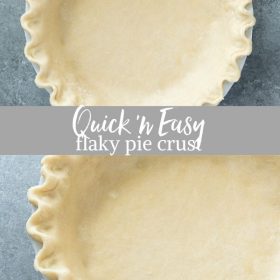
Make Flaky Pie Crust in your food processor with 3 simple ingredients and about 15 minutes of prep. Homemade pie crust has never been easier!
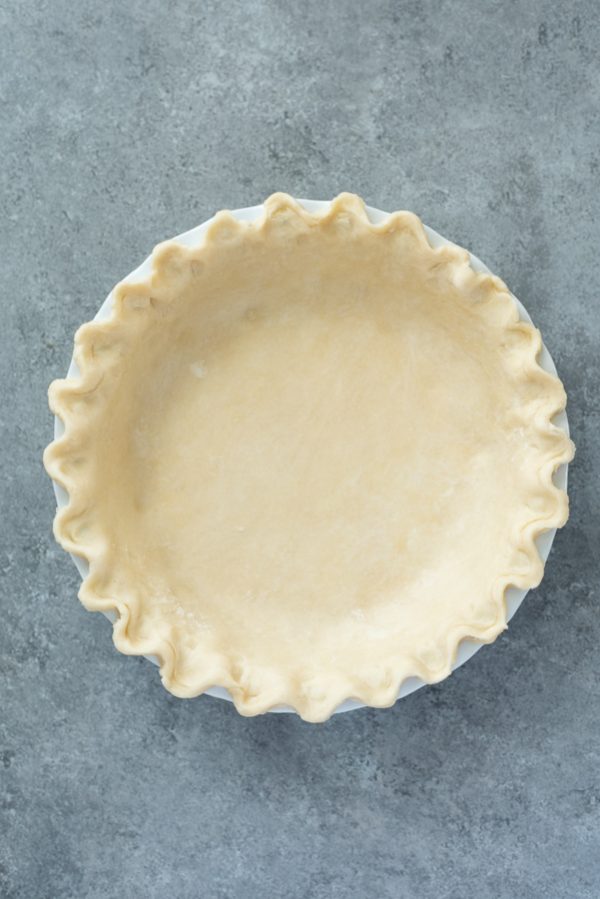
**The photos and text for this post were updated in November 2019.
Halloween is only days away, but I haven't been feeling it this year. You could even say I'm a bit bah-humbug about it. I've decorated my house, but I have yet to get a pumpkin on the doorstep and haven't purchased any Halloween candy yet.
My kids are older, so the fun has been taken out of Halloween. They're too old to trick-or-treat, and they don't really want to go to the pumpkin patch with me anymore.
Ah, where does the time go?
I'm hosting Thanksgiving again this year, which definitely helps to take my mind off of Halloween. I'm specifically focused on PIE. 🙂
Flaky Pie Crust
A few years ago I was insanely intimidated by making homemade pie crust, and stuck to graham cracker crusts only, thank you very much.
That changed after I went to cooking school and made homemade pie crust countless times. I can honestly say I have no idea why I was such a chicken.
Pie crust is easy.
Are you intimidated by making pie crust from scratch??
If you answered yes, you're in the right place. I'll show you how to make this flaky pie crust recipe with 3 simple ingredients in about 15 minutes.
And we're making it in a food processor!
Pie crust ingredients:
All the ingredients for a buttery flaky pie crust are below.
These are barely even ingredients since we always have these on hand, don't we?
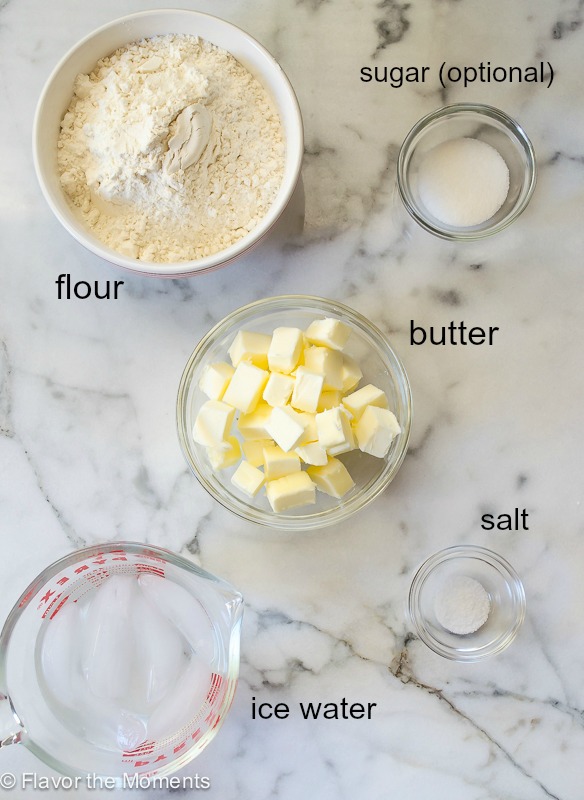
How to make homemade pie crust:
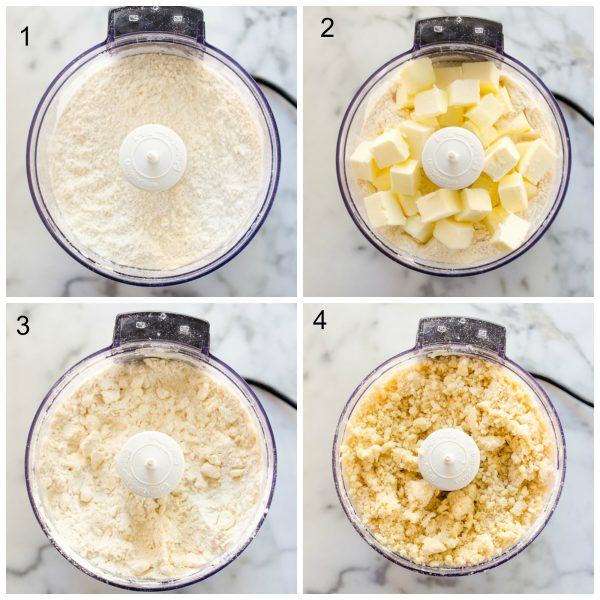
- Place the flour, sugar, and salt in the bowl of the food processor and pulse about 5 times to combine (Figure 1).
- Add the cubed butter (Figure 2), and if you're butter is frozen, you'll have even better results. Pulse in short, quick pulses (do not process!) until it resembles coarse meal or peas as shown in Figure 3. You want to see clumps of butter — that's a good thing.
- Add 3 tablespoons of water through the feed tube while pulsing in short, quick pulses once again. Be careful not to pulse too much — just until the water is incorporated. Remove the lid and check the dough. If you can pinch it together and it holds, it's fine. If it's still dry, add 1-2 tablespoons more, 1 at a time, incorporating it with short, quick pulses once more, until it's cohesive as shown in Figure 4.
As you can see from the photo below, the crust holds together nicely and is not too wet.
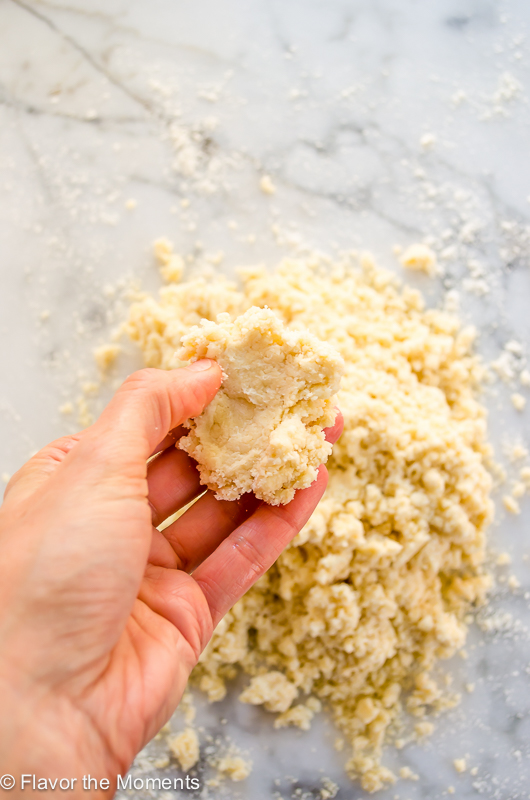
- Next, turn the dough out onto your work surface, and knead it together with your hands and form it into a disk.
- Wrap it in plastic wrap, and chill the dough for about 30 minutes prior to rolling to relax the gluten and chill that butter back up!
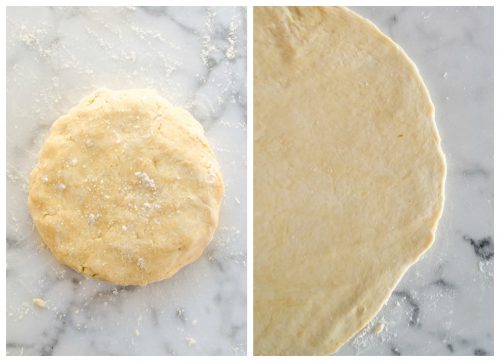
- Once chilled, unwrap the dough and place on a lightly floured work surface. Sprinkle the dough and flour your rolling pin, and roll the dough out from the middle to the outer edge, going in about 10 minute intervals clockwise. After every couple of rolls, make sure to lift the dough and sprinkle more flour underneath to prevent sticking. If the dough does stick, scrape any bits of dough from your work surface as it's a magnet for even more sticking.
- Pie crust can be a sticky situation, but it's manageable. Just remember to keep that work surface floured. 🙂
- Roll the dough until it's large enough to hang over the edge of your pie pan by a couple of inches. Once it's large enough, use your rolling pin to gently roll the dough around it, and unroll it right into your pie plate.
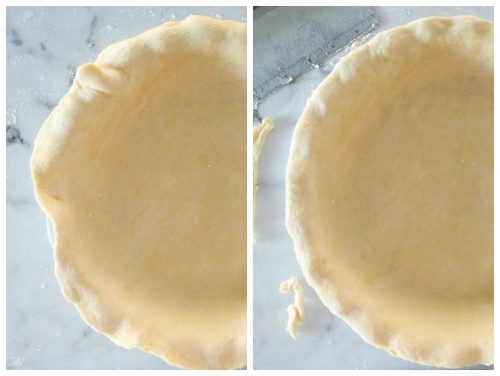
- Tuck the dough gently into the inside of the pie pan, then use a bench scraper or knife to trim the edges around the top of the pie.
- Leave about an inch or so of dough over the edge as the dough will shrink a bit.
- From there, crimp your edges as best as you can (I'm far from perfect!), or use the scraps to cut out decorative shapes.
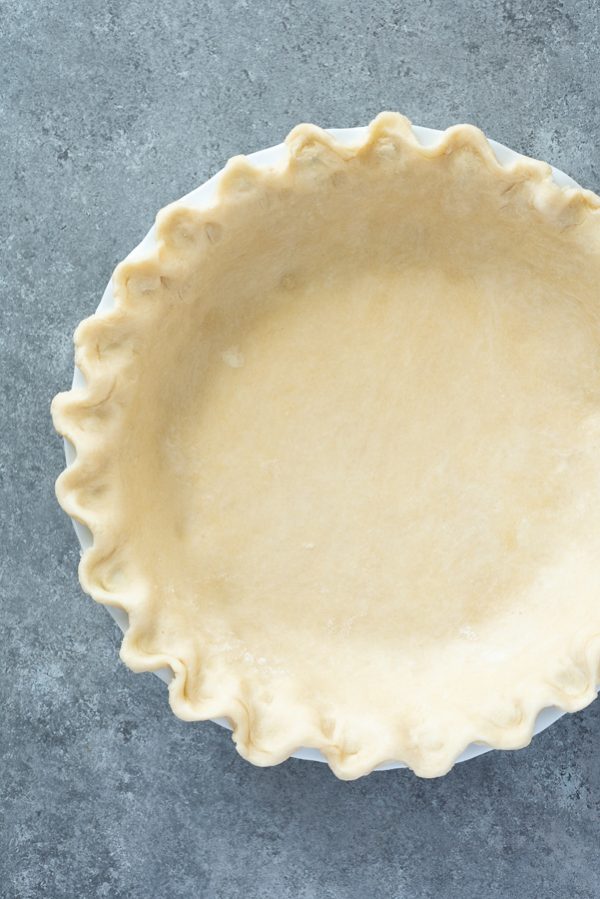
Frequently asked questions
Do you have to chill pie crust?
For best results, pie crust must chilled. Chilling the dough allows the gluten strands to relax and the butter to stay cold, which is essential for a flaky pie crust.
How to roll a pie crust
Turn your chilled pie crust out onto a lightly floured work surface. Rolling the dough on a silpat mat, marble board or even parchment paper will help prevent the dough from sticking.
Roll from the middle outward, turning the dough in 10 minute increments like a clock, dusting with flour underneath as needed.
The dough should be about 1-2″ wider in circumference than your pie plate.
How do you fix a crumbly pie crust?
If your pie crust is crumbly and hard to roll, it's lacking moisture. Try sprinkling a small amount of water over the pie dough and work it in as gently as possible to prevent overworking the dough.
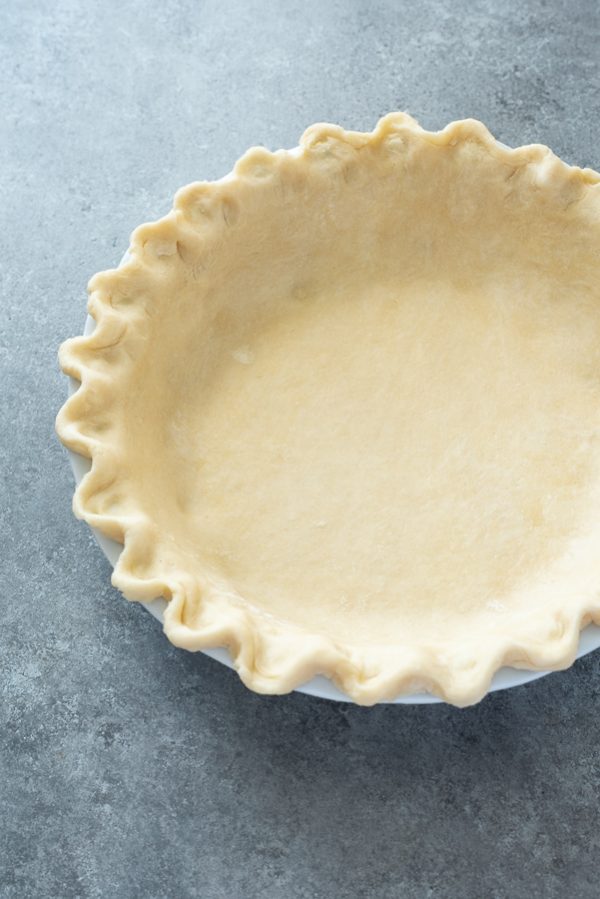
Why does a pie crust shrink during baking?
Pie crust shrinks if the gluten hasn't been given time to relax. To prevent your flaky pie crust from shrinking, chill the dough for 15 minutes after rolling it out.
I typically prepare my pie filling while my pie dough is in the refrigerator chilling.
What is the purpose of egg wash?
An egg wash will give your pie a beautiful golden brown sheen.
Simply combine an egg with a few tablespoons of cold water and brush it over the pie crust with a pastry brush.
I normally only use egg wash for a pie with a top crust or a galette.
Should I bake the bottom crust first?
Baking the bottom crust before filling is referred to as blind baking. This process bakes the bottom crust to prevent it from getting soggy, which is especially necessary for fruit pies.
See this post How To Blind Bake Pie Crust for more information.
Recipe notes and substitutions
- Omit the sugar for a savory pie crust.
- Make this flaky pie crust 1-2 days in advance and store in the refrigerator wrapped tightly in plastic wrap. Let stand at room temperature until it's just soft enough to roll.
- Frozen pie crust will keep wrapped tightly in plastic wrap or a freezer bag for up to 3 months. You can either freeze it in a flattened disk, or rolled out and crimped in a pie pan. Thaw in the refrigerator overnight before using.
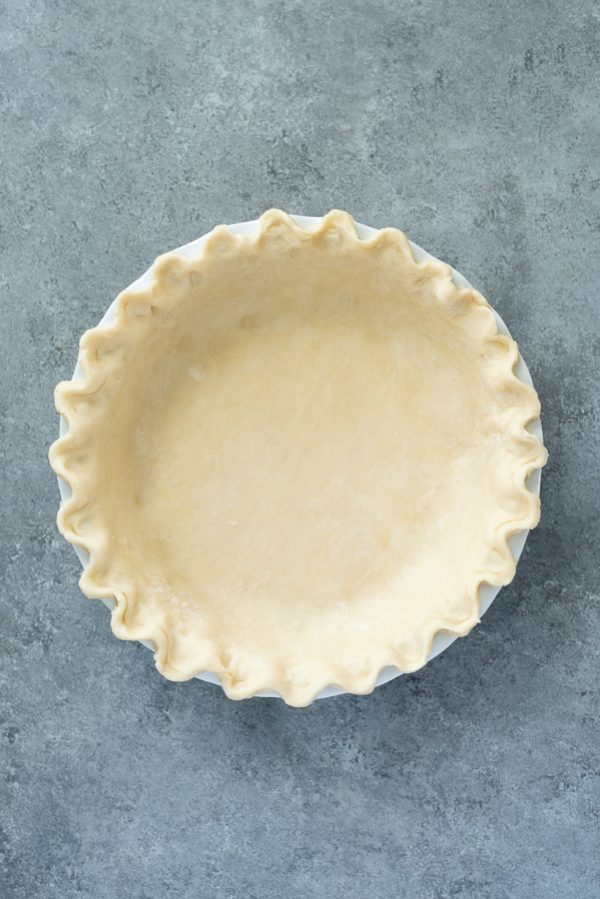
Pie recipes for your flaky pie crust:
Chai Spiced Pumpkin Pie
Pear Ginger Crumble Pie
Quick and Easy Flaky Pie Crust
Make Flaky Pie Crust in your food processor with 3 simple ingredients and about 15 minutes of prep. Homemade pie crust has never been easier!
- 1¼ cups all purpose flour plus more for flouring your work surface
- 1 tablespoon granulated sugar omit if pie crust is for a savory pie
- ⅛ teaspoon salt
- 4 ounces unsalted butter cut into small cubes (freeze the butter cubes for 20-30 minutes prior to use for best results)
- 3-5 tablespoons ice water*
-
Place the flour, sugar, and salt in the bowl of your food processor and pulse about 5 times until combined. Add the cubed butter and pulse in short, quick pulses (do not process!) until it resembles coarse meal or peas. You want to see clumps of butter -- that's a good thing.
-
Add 3 tablespoons of water through the feed tube while pulsing in short, quick pulses once again. Be careful not to pulse too much -- just until the water is incorporated. Remove the lid and check the dough. If you can pinch it together and it holds, it's fine. If it's still dry, add 1-2 tablespoons more water, 1 tablespoon at a time, incorporating it with short, quick pulses once more, until it's cohesive.
-
Turn the dough out onto your work surface, and knead it together with your hands and form it into a disk. Wrap it in plastic wrap, and chill the dough for about 30 minutes prior to rolling to relax the gluten and chill that butter back up!
-
Once chilled, unwrap the dough and place on a lightly floured work surface. Sprinkle the dough and flour your rolling pin, and roll the dough out from the middle to the outer edge, going in about 10 minute intervals clockwise around to form a circle. After every couple of rolls, make sure to lift the dough and sprinkle more flour underneath to prevent sticking. If the dough does stick, scrape any bits of dough from your work surface as it's a magnet for even more sticking.
-
Roll the dough until it's large enough to hang over the edge of your pie pan by a couple of inches. Once it's large enough, use your rolling pin to gently roll the dough around it, and unroll it right into your pie plate.
-
Tuck the dough gently into the inside of the pie pan, then use a bench scraper or knife to trim the edges around the top of the pie. It's ok to leave a little extra for crimping, etc. as the top does shrink a bit.
-
From there, crimp your edges as best as you can, or use the scraps to cut out decorative shapes.
- Yields (1) 9" pie crust. Recipe is easily doubled for a double crust pie.
- Omit the sugar for a savory pie crust.
- *Always start with the minimum amount of water, and add only 1 more tablespoon at a time until the dough is cohesive. The amount of water you need will vary.
- Make this flaky pie crust 1-2 days in advance and store in the refrigerator wrapped tightly in plastic wrap. Let stand at room temperature until it's just soft enough to roll.
- Pie dough may be frozen immediately after making it in a food processor -- just wrap it tightly in plastic wrap in more of a flattened disk for easier rolling once thawed, and wrap in foil as well. You may also freeze it in a plate that is freezer safe, wrapped in plastic wrap and foil. Thaw in the refrigerator over night
Serving: 1 g , Calories: 179 kcal , Carbohydrates: 16 g , Protein: 2 g , Fat: 12 g , Saturated Fat: 7 g , Cholesterol: 30 mg , Sodium: 38 mg , Potassium: 21 mg , Fiber: 1 g , Sugar: 2 g , Vitamin A: 354 IU , Calcium: 6 mg , Iron: 1 mg
Nutrition is estimated using a food database and is only intended to be used as a guideline for informational purposes.
All recipes and images © Flavor the Moments.
Source: https://flavorthemoments.com/quick-and-easy-flaky-pie-crust/
0 Response to "Easy Flaky Pie Crust Top and Bottom"
Post a Comment